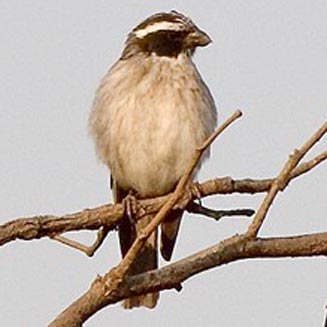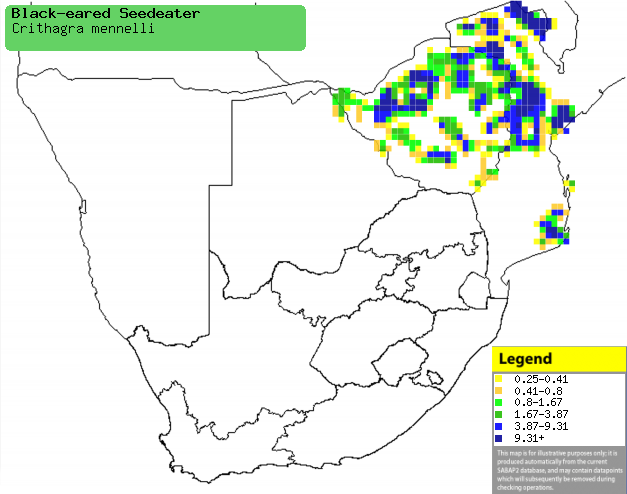|
Crithagra mennelli (Black-eared
seedeater, Black-eared canary)
[= Serinus mennelli]
Swartoorkanarie [Afrikaans]; Zwartwangkanarie [Dutch]; Serin
oreillard [French]; Schwarzwangengirlitz [German]; Canário-de-mascarilha
[Portuguese]
Life
> Eukaryotes >
Opisthokonta
> Metazoa (animals) >
Bilateria >
Deuterostomia > Chordata >
Craniata > Vertebrata (vertebrates) > Gnathostomata (jawed
vertebrates) > Teleostomi (teleost fish) > Osteichthyes (bony fish) > Class:
Sarcopterygii (lobe-finned
fish) > Stegocephalia (terrestrial
vertebrates) > Tetrapoda
(four-legged vertebrates) > Reptiliomorpha > Amniota >
Reptilia (reptiles) >
Romeriida > Diapsida > Archosauromorpha > Archosauria >
Dinosauria
(dinosaurs) > Saurischia > Theropoda (bipedal predatory dinosaurs) >
Coelurosauria > Maniraptora > Aves
(birds) >
Order: Passeriformes > Family: Fringillidae
 |
|
|
Black-eared seedeater, DRC. [photo
Neil Gray
©] |
|
Distribution and habitat
Occurs from southern DRC and Tanzania through Angola,
Zambia and Malawi to southern Africa, where it is uncommon to locally common in
Zimbabwe and central, northern and south-eastern Mozambique. It generally
prefers miombo (Brachystegia), Zambezi teak (Baikiaea plurijuga)
and mahobohobo (Uapaca) woodland, especially on Kalahari Sands. It also
occupies mixed munondo (Julbernadia) and Mountain acacia (Brachystegia
glaucescens) woodland, fields and degraded coastal forest.
|
 |
|
Distribution of Black-eared seedeater in southern Africa,
based on statistical smoothing of the records from first SA Bird Atlas
Project (©
Animal Demography unit, University of
Cape Town; smoothing by Birgit Erni and Francesca Little). Colours range
from dark blue (most common) through to yellow (least common). |
Movements and migrations
Resident and mostly sedentary, although it may
make seasonal movements as it is most common in southern Zimbabwe in
the period from September-March.
Food
It mainly eats seeds, fruit and flowers, doing most of its
foraging on the ground and in grass tufts, occasionally along with other canary
species. The following food items have been recorded
in its diet:
- Seeds
- grasses
- Loudetia simplex (Common russet grass)
- Hyparrhenia (thatching grass)
- Helianthus (sunflower)
- Fruit
- Trema orientalis (Pigeonwood)
- mistletoes (Loranthaceae)
Breeding
- Monogamous, territorial solitary nester, with males calling from perches
or while gliding between trees.
- The nest is a distinctive cup mostly made out of old-man's-beard lichen
(Usnea), bound with spider web and sometimes including bark and a few
twigs. It is typically placed in the fork of a thin branch near the top of a
Musasa (Brachystegia spiciformis) tree.
- Egg-laying season is from September-April, peaking from
January-February.
- It lays 2-3 eggs, which are incubated solely by the female for about 13
days (recorded in captivity).
- In captivity the chicks leave the nest at about 18 days old.
Threats
Not threatened, although destruction of miombo (Brachystegia)
woodland in Zimbabwe is cause for concern.
References
-
Hockey PAR, Dean WRJ and Ryan PG 2005. Roberts
- Birds of southern Africa, VIIth ed. The Trustees of the John Voelcker
Bird Book Fund, Cape Town.
|
